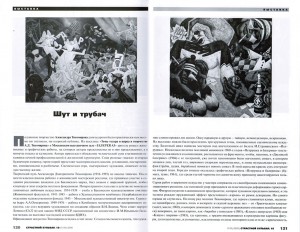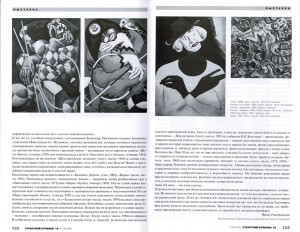Irina Reshetnikova,
Strastnoy boulevard’ magazine, # 9-119/2009.
True art of Alexander Tikhomirov remained for a long time practically unknown both to the connoisseurs and the broad audience.
Visitors of the ‘Themes of theatre and circus in the art of A.D. Tikhomirov’ exhibition held at the Moscow Exhibition Hall ‘GALLERY A3’ could see his pictorial and graphic works, depicting the actors not during the performance, but when resting behind the curtains. The author is interested in denudation of the human essence in the moments when endless flow of professional and life events stops. With their role ‘masks’ off and their everyday reverse side out, the heroes sometimes appear to be unattractive, tired, aged, worn out and broken. As underlined by the artist, scenic performance takes up a sufficient part of their life.
Creative development of Alexander Dmitrievich Tikhomirov (1916–1995) is not quite a typical one. After six years at school he worked at the Pictorial Advertising Studio, where he was engaged in work on promotional posters for Baku circus, was acquainted with the circus troupe, admired clownery and knew the secrets of the local illusionists. Loss of his right eye in early childhood did not prevent him from going in for art, so dearly loved by him. In 1934-1938 he studied at Baku Art College (Pictorial Department). In 1941–1945 he worked at the Art Concern (Azerbaijani Department of Art Foundation). In 1945 he studies at the Surikov Moscow Art Institute (the course of A.A. Osmyorkin). In 1949–1976 he worked at the Monumental-Decorative Art Concern, where he became the leading artist in charge of portraits of V.I. Lenin. One of his most outstanding works is Lenin’s portrait (42 x 22 m) on the frontage of the building of the Ministry of Foreign Affairs of USSR, done jointly with I.M. Ilyin (awarded with the Golden medal at the Visual Propaganda Exhibition in the Exhibition of Economic Achievements).
That was the time of Tikhomirov’s official art. Nowadays we may say that the artist seemed to have two lives. One of them was a ‘front’ life, and the other – secret life, which was a confessionary, a true one.
Three main themes devoted to the scenic art could be traced at the exhibition. The ballet cycle was painted by the artist under impression of I. Stravinsky’s ballet ‘Petroushka’. Several oil paintings of 1960-es ‘Petroushka and the ballet dancer’ gradually grow more complex in composition, falling into fragments, until it becomes almost impossible to see the plot in ‘Double-faced ballet dancer’ (1966) with its garishness, mixed-up mosaic of faces, parts of the bodies and circus equipment; and only the musical iconography (horns, pipes, drums) help understanding the plot. Graphic ‘Petroushka and the ballet dancer’ (paper, ink; 1961) is a much more delicate work, where, following the scenic principles, only the faces are emphasized against the thick darkness.
The master’s series of works about the circus art is associated with peculiar vision of the compositional solutions, with the main emphasis on plastic deformation of depicted characters. The figures are uncomfortable inside the pictorial space, squeezed by the artist to the limit, and this narrowness gives a spring effect of forthcoming ‘explosion’ beyond the margins of decorations. However, the explosion itself did not happen. That is why a number of Tikhomirov’s canvas with the clown as a main character are slightly monotonous, differing only in colors and scanty change in postures – from ‘Tragic clown’ (canvas, oil; 1960), with dominating dark grey and orange colors shading endless melancholy of the carpet clown, and down to such paintings as ‘Acrobat with the parrot’ (1985), ‘Clown with the parrot’ (1985) or ‘Clown with the balls’ (1985) with large figures, hardly fitting into the pictorial space, and their half-bent, broken, tilted heads repeating one and the same: crookedness, deformation of human poses, violence of impersonation…
And still, it’s not for a pure coincidence that art expert and completist Vladimir Moskvinov called the artist ‘Soviet Michelangelo’. Perhaps, space chamber, which Tikhomirov’s circus performers are trying to break through, proceed from tragic past of the real court jesters, whose buffoonery has been a part of more horrifying vale – whether you react to varying smiles of ‘The Motley’ (paper, tempera; 1993) or dive into sorrow of ‘Sad motley’ (paper, tempera; 1984). Are you turning around to look back at the painting ‘Shakespeare’s melodies’ (canvas, oil; 1984) as if you hear the heart of its hero asking a question: is there a Fate by the feet of the Power? Along with tragically laughing expression of thickly made-up face, throwing a scary shadow from such mixture of emotions: Laughter and Death.
Gradually the procession of faces becomes more contemporary in ‘Travelling show’ (paper, ink; 1969) and ‘Circus’ (canvas, oil; 1983). Signs of ‘Nemukhin’s symbols’ start appearing – for instance, the motive of scattered playing cards in ‘Pantomime’ (canvas, oil; 1972) or ‘Circus’ (paper, tempera; 1983). The artist is no longer concerned about the future of a player; he is worried about unjust principle of the world’s foreground as such. The motive of a play becomes more and more persistent and at the same time more alarming and pessimistic. And if looking at ‘Before the opening night’ (paper, tempers; 1980-es) we still manage to catch a sight of diverse emotional patterns from behind the curtains, in ‘Theatric vesper’ (canvas, oil; 1984) we see a variety of hands of a costumed gathering (Harlequin, Columbine, clown) on the disc of a table, a candlestick, a rose, bottles and glasses, officiating some secretive ritual. We shall not meet the eyes of the heroes anymore.
Clearly, large Tikhomirov’ canvas combine the essence of different eras, gradually revealing original vision of the artist. For instance, ‘The theatre’ (canvas, oil; 1988) from the collection of V.A. Matveev brings into one whole a street theatre and, I dare say, a religious-mystical pantheon of Christian faith. We see here both troubadours, and angels with tambourines in their hands, and clowns, and pantomime… ‘Feast of the actors’ (canvas, oil; 1985) from the collection of V.V. Zhigunov – is a continuation of a spectacular art in everyday life with overlapping reflections – plasticity of two curved dames in a black and the old wrinkled face of one of them in a mirror, with no make-up, with a pair of watching clowns nearby, and, finally, hands in black gloves, sending the spectators straight to the shadow show. One would think it is a Feast. And still, it is not a feast of play-actors, but a complete powerlessness of self-giving – the play takes energy without leaving anything instead – only emptiness and covers. Result of the ‘Feast of the actors’ (paper, ink; 1968) or several versions of ‘Actors by the table’ (canvas, oil; 1979; 1980) – are again playing cards, bottles, glasses, scattered cigarettes… Drunk and dissipated environment, extremely bright and colorful, but for all that irredeemable (and perhaps it is a burst of expressivity, excess of colors in which it is presented by the author that makes it so desperate). However, bright splashes of colors sprouting with flaming aurora, as it would seem, the fountains of life-asserting variegation, failed to subdue and extinguish pessimistic views in the theatric environment.
Face of the ХХ century is a face of the clown…
It’s a pity that organizers of the exhibition did not pay attention to the official life of the master, also painting Leniniana. To a large extent here we may find the source of his tragic view of life, see a shadow of ambivalence, traces from life in a joyful mask. And still, ‘Gallery A3’ accomplished a successful project, having enriched the history of Soviet art by one more name; the fact that in his lifetime Tikhomirov did not often displayed his works, makes this exhibition interesting. Tragic motley did not fit in where there was a need for the court flatterer, praising the king, and where bitter laugh drowned in fanfares.

